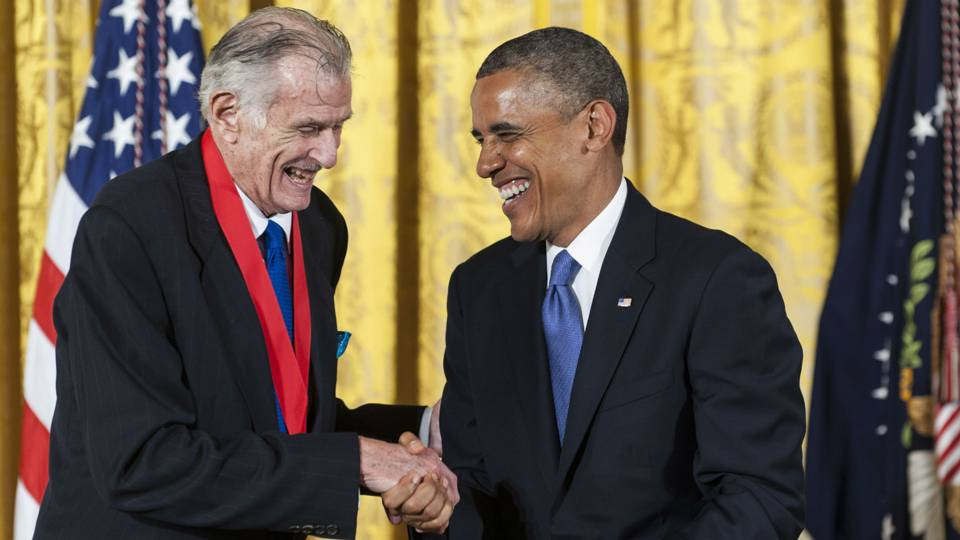Benjamin Franklin Deford III was born on December 16, 1938 in Baltimore, 3 days after 1960s Baltimore Bullets basketball star Gus Johnson (no connection besides name to the current basketball broadcaster), and 4 days after singer Connie Francis.
When Gus died, Frank (never "Ben" or "Benny") wrote a column about how he imagined himself, Gus and Connie going through life together, like the Scarecrow, the Tin Man and Dorothy on the Yellow Brick Road in The Wizard of Oz. I guess he didn't want to call anyone the Cowardly Lion, but he was born 1 day after AFL legend Billy Shaw, on the same day as actress Liv Ullman, and 1 day before mile run recordholder Peter Snell.
He grew up in Baltimore, a fan of the International League version of the Baltimore Orioles, who won Pennants in 1944 and 1950, when he was 5 and 11 years old, respectively. By the time the St. Louis Browns were moved to become the major league version of the Orioles in 1954, he was already at the Gilman School, a Baltimore prep school; by the time they won their 1st Pennant in 1966, he was already at Sports Illustrated.
(Other Gilman graduates include former Maryland Governor Bob Ehrlich, former Arizona Governor Fife Symington, Maryland Congressman John Sarbanes, and Walter Lord, author of A Night to Remember, the defining book about the RMS Titanic.)
He went to Princeton, leading a female editor at SI to tell him, "Deford, you are the last of the tall white male heterosexual Ivy League writers." Along the same lines, he titled a collection of his writings The World's Tallest Midget. (He was 6-foot-4.)
After graduating in 1962, SI hired him as a researcher, and he later became one of its best writers. He was renowned for "The Toughest Coach There Ever Was," his 1984 profile of Bob Sullivan, the head football coach at East Mississippi Junior College in the 1950s and '60s, a Marine veteran who was the only survivor of his squad on Okinawa, and a man so tough he had 2 nicknames, and was often referred to by both of them at the same time: "Bull Cyclone." At 18 pages, it is still the longest article in SI's 63-year history.
In 1988, on the Centennial of Ernest Thayer's poem "Casey At the Bat," he wrote "Casey On the Loose," first as an SI piece, then as an entire novel, imagining "The Mighty Casey" as a real person, and giving the ill-fated slugger a weird, but still better, ending to his famous game.
In his epilogue, Deford imagined, among other things, that Timothy Francis Xavier Casey's sister Kate was not only the Katie Casey mentioned by Jack Norworth in "Take Me Out to the Ballgame," but also that she was the mother of Babe Ruth. (The Babe's mother was named Kate, but she was a German-American, Katherine Schamberger, not an Irish lass named Katherine Casey.)
He wrote a biography of tennis legend Bill Tilden, a novel about college football titled Everybody's All-American (turned into a movie starring Dennis Quaid), books about roller derby, the Miss America pageant, and the New York Giants of John McGraw, The Old Ball Game. He also contributed a piece on the minor-league Orioles to his SI colleague Ron Fimrite's fantastic anthology Birth of a Fan.
In 1965, he married fashion model Carol Penner. They had 2 children, a son Christian and a daughter Alexandra, or Alex. Alex developed cystic fibrosis, and died at age 8 in 1980. Frank became an advocate for fighting CF, and wrote a memoir of his daughter, Alex: The Life of a Child. It became a TV-movie starring Coach star Craig T. Nelson and Bonnie Bedelia. Shortly after Alex's death, Frank and Carol adopted an infant girl from the Philippines, whom they named Scarlet. Frank lived to see 2 grandchildren.
In 1980, he began a weekly show on National Public Radio. In 1989, he stepped aside from SI to help found The National Sports Daily, or The National for short. He became editor-in-chief, and the paper was first published on January 31, 1990. Most countries have at least 1 national daily newspaper devoted exclusively to sports, but it had never been tried in America. It sounded like a great idea.
The timing was horrible: Not only was ESPN making such an idea obsolete, but the price of both paper and ink had skyrocketed, and all over America, newspapers were dropping like flies, some going out of business, some merging with the more successful paper in their city. On June 13, 1991, it published its last issue.
The first and last front pages.
The New York edition of the first front page
had Patrick Ewing; the Chicago edition, Michael Jordan.
Frank was welcomed back to SI, stuck with his NPR show, and became a correspondent for HBO's Real Sports with Bryant Gumbel. He was 6 times voted National Sportswriter of the Year, won an Emmy Award in 1988, won a Cable ACE Award in 1993 for his HBO documentary on tennis icon Arthur Ashe, won a Peabody Award in 1999, was elected to the National Sportscasters and Sportswriters Association Hall of Fame, and was awarded the National Humanities Medal by President Barack Obama in 2013.
Frank Deford lived in Key West, Florida, and died there this past Sunday, May 28, 2017. He was 78 years old.
He was 6-foot-4, but in a world where sports and journalism not only both seem to be out of control, but don't seem to go together at all, he seems taller than ever. In death, as in life, he shall cast a very long shadow.
UPDATE: He was buried at Christ and Holy Trinity Church Cemetery, in the New York suburb of Westport, Fairfield County, Connecticut.




No comments:
Post a Comment